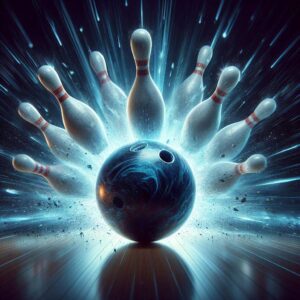Bowling is a sport that requires a delicate balance of power, precision, and finesse. One of the most crucial elements that separates the good bowlers from the great ones is the ability to control the curve of the bowling ball.
Whether it’s a smooth, arcing hook or a dramatic, angular curve, the way the ball moves down the lane can mean the difference between striking down all the pins or leaving a frustrating split.
But have you ever wondered why bowling balls curve in the first place? What are the underlying scientific principles that govern the movement of the ball, and how can bowlers leverage this knowledge to improve their game?
In this comprehensive guide, we’ll dive deep into the mechanics behind bowling ball curve, exploring the physics, the ball design, and the techniques that allow skilled bowlers to consistently shape the path of their deliveries.
What Causes Bowling Balls to Curve?
At the heart of bowling ball curve is the concept of ball rotation, or spin. When a bowler releases the ball, they impart a combination of forward momentum and rotational force, causing the ball to spin as it travels down the lane. This spin is the key factor that determines the curve of the ball’s trajectory.
The Physics of Bowling Ball Curve
To understand the science behind bowling ball curve, we need to delve into a few key physical principles:
- Gyroscopic Effect: As the bowling ball spins, it creates a gyroscopic effect, similar to a spinning top or gyroscope. This gyroscopic force causes the ball to resist changes in the direction of its axis of rotation. In other words, the ball wants to continue spinning along the same plane, rather than deviating off course.
- Coanda Effect: The Coanda effect is a phenomenon where a fluid (in this case, the air) tends to follow the contours of a curved surface, rather than taking a straight path. As the spinning bowling ball rolls down the lane, the Coanda effect causes the air on one side of the ball to follow the curve of the ball’s surface, creating a difference in air pressure. This pressure differential is what ultimately causes the ball to curve.
- Friction and Ball Surface: The surface of the bowling ball, as well as the friction between the ball and the lane, also play a crucial role in the ball’s curve. The ball’s coverstock (the outer layer) and the lane’s surface conditions can create more or less friction, which affects the ball’s ability to “grip” the lane and generate the desired curve.
Putting these physics principles together, we can see how a spinning bowling ball curves as it travels down the lane:
- The gyroscopic effect causes the ball to resist changes in its axis of rotation, keeping it spinning along the same plane.
- The Coanda effect creates a difference in air pressure on the sides of the spinning ball, causing it to curve towards the side of the ball with lower air pressure.
- The friction between the ball’s surface and the lane helps the ball “bite” into the lane, allowing the spin and curve to take effect.
Different Types of Bowling Ball Curves
Given the complex interplay of physics and mechanics, it’s not surprising that there are several distinct types of bowling ball curves that skilled bowlers can leverage:
- Hook: The most common and desirable type of curve is the “hook,” where the ball starts out straight and then dramatically curves towards the target pins. For right-handed bowlers, the ball will curve from right to left, while left-handed bowlers will see a curve from left to right. The degree of the hook can vary depending on factors like ball design, bowling style, and lane conditions.
- Banana/Curve: A “banana” or “curve” ball refers to a more gradual, arcing curve that doesn’t have the sharp, angular hook. This type of curve is often used on drier or more worn lane conditions, where the ball needs to navigate a longer, more consistent path to the pins.
- Straight Ball: While not technically a “curve,” some bowlers prefer to use a straight ball, which maintains a linear trajectory down the center of the lane. This can be an effective strategy on certain lane conditions or for specific spare-shooting situations.
The type and degree of curve a bowler can achieve depends on a variety of factors, including the ball’s design, the bowler’s release and technique, and the conditions of the lane.
Mastering Ball Curve for Better Bowling
Now that we understand the science behind bowling ball curve, let’s explore how bowlers can harness this knowledge to improve their game.
Developing Ball Control and Curve
The key to generating and controlling the curve of a bowling ball comes down to two primary factors: ball release and ball design.
Ball Release Technique – The way a bowler releases the ball is crucial for imparting the desired spin and curve. A proper release involves:
- A smooth, consistent backswing to build up rotational momentum
- A balanced, upright posture throughout the delivery
- A firm wrist position that allows the fingers to “roll” the ball off the fingers
- A solid follow-through that maintains the ball’s spin and direction
By perfecting their release technique, bowlers can consistently generate the kind of spin and axis tilt that produces the curve they’re looking for.
Ball Design and Drilling – The construction and drilling layout of the bowling ball also play a significant role in determining the ball’s curve. Key factors include:
- Ball weight and core design: Heavier balls with asymmetric cores tend to generate more hook than lighter, symmetric-core balls.
- Surface texture and coverstock: Balls with rougher or more porous coverstocks will grip the lane better, creating more curve.
- Drilling layout: The position of the finger and thumb holes, as well as the axis of rotation, can be adjusted to fine-tune the ball’s hook potential.
By carefully selecting the right ball for their style and drilling it to their specific needs, bowlers can maximize their ability to generate and control the curve of their deliveries.
Adapting to Lane Conditions
Of course, bowling ball curve isn’t just about the equipment and technique – the conditions of the bowling lane itself can have a significant impact. Factors like:
- Lane oil pattern: Heavily oiled lanes tend to produce less friction, leading to straighter ball trajectories. Drier, more worn lanes allow for more hook.
- Lane surface: The texture and material of the lane can also affect ball motion, with some surfaces being more or less responsive to spin.
- Temperature and humidity: Environmental conditions can subtly influence the ball’s interaction with the lane, affecting curve.
Skilled bowlers learn to read the lane conditions and make adjustments to their ball choice, release, and approach to optimize their curve and overall performance.
Developing Curve Control Through Practice
Like any skill in bowling, mastering ball curve takes time, dedication, and deliberate practice. Bowlers can work on their curve control through a variety of drills and exercises, such as:
- Targeting specific pins with different curves
- Practicing releases with varying degrees of tilt and rotation
- Experimenting with different ball layouts and coverstocks
- Adjusting approach and release based on lane conditions
By consistently practicing and refining their technique, bowlers can develop a keen sense of feel and control over the curve of their shots, giving them a powerful tool to navigate the complexities of the sport.
Conclusion
The curve of a bowling ball is a captivating and complex phenomenon, rooted in the principles of physics, engineering, and human skill. By understanding the gyroscopic effects, the Coanda effect, and the role of friction and ball design, bowlers can unlock the secrets to consistently shaping the path of their deliveries.
Whether it’s a sharp, angular hook or a smooth, arcing curve, mastering ball curve is a crucial element of becoming a well-rounded and competitive bowler.
By developing the right techniques, choosing the optimal equipment, and adapting to lane conditions, bowlers can harness the power of spin and leverage the science of bowling ball motion to achieve their goals and take their game to new heights.
So the next time you step up to the line, keep these principles in mind and let the curve of your ball be your guide. With practice and persistence, you’ll be baffling your opponents and knocking down pins with precision and style.





